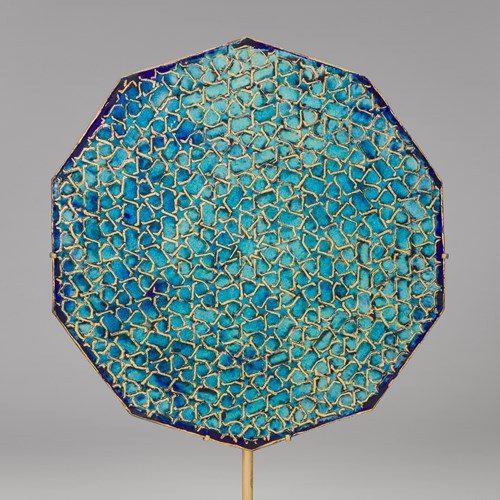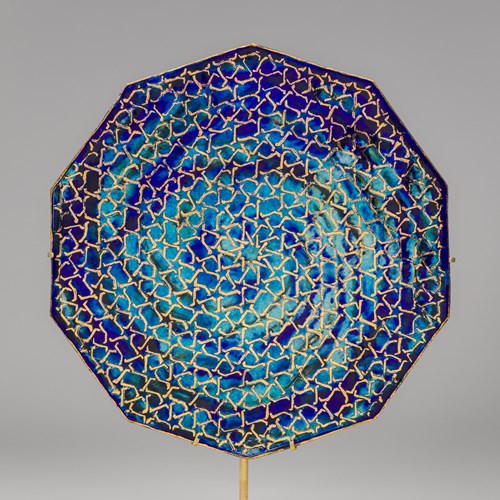Marketplace
Chinese Blue-and-White Huqqa Base Made for the Indian Market
Chinese Blue-and-White Huqqa Base Made for the Indian Market
Date 1662-1722
Epoque 17th century, 18th century, Kangxi period (1662-1722)
Origine China
Medium Ceramic
Dimension 20 cm (7⁷/₈ inches)
Kangxi period (1662-1722)
The compressed globular body of Indian form, painted in underglaze blue with three panels of depictions of Chinese antiques decorated on a cracked ice and prunus background. The neck and cup also painted with a cracked ice and prunus ground with an unglazed and rounded base.
The form of this huqqa base derives from 17th century Indian prototypes which were made from a variety of different materials including metal, glass and precious stones. A very similar huqqa base in the Riesco Collection was included in the OCS exhibition, Chinese Blue and White Porcelain, 14th to 19th Centuries, London, 1953-1954, no. 258 (incorrectly illustrated as no. 259, pl. 16d). An example of the same shape and same period but in famille verte enamels, decorated with stylised Islamic calligraphy, is in the British Museum, no. 1956, 1017.2, donated to the museum by R Soame Jenyns and exhibited in the museum’s exhibition ‘Fascination with Nature’ 10th January – 5th August 2008. Two further examples are in the collection of the Victoria & Albert Museum, one decorated with floral garlands in underglaze blue, originally bought in Iran, museum no. 1596-1876, the other from the Salting Bequest decorated in a café-au-lait glaze with blue and white medallions, museum no. C.959-1910. Another example in underglaze blue and white of the same form is in the collection of the Topkapi Saray Palace, TKS 15/4312, illustrated in John Ayers, Regina Krahl and others, Chinese Ceramics in the Topkapi Saray Museum, Istanbul, London, 1986, 3 quarto vols, pl. 2084, p. 987. Another blue and white example is illustrated in Art from the World of Islam in The David Collection, Dr Kjeld von Folsach, Copenhagen, 2001, pl. 242, p. 179. A similar Chinese blue and white porcelain huqqa is illustrated in a Golkonda portrait of a prince seated in a garden setting, circa 1675, see Ludwig V. Habighorst, Love For Pleasure: Betel, Tobacco, Wine and Drugs in Indian Miniatures, Ragaputra Edition, Koblenz, 2007, p. 47 and 48, fig. 22, 23.
Stock no.: A4642
The compressed globular body of Indian form, painted in underglaze blue with three panels of depictions of Chinese antiques decorated on a cracked ice and prunus background. The neck and cup also painted with a cracked ice and prunus ground with an unglazed and rounded base.
The form of this huqqa base derives from 17th century Indian prototypes which were made from a variety of different materials including metal, glass and precious stones. A very similar huqqa base in the Riesco Collection was included in the OCS exhibition, Chinese Blue and White Porcelain, 14th to 19th Centuries, London, 1953-1954, no. 258 (incorrectly illustrated as no. 259, pl. 16d). An example of the same shape and same period but in famille verte enamels, decorated with stylised Islamic calligraphy, is in the British Museum, no. 1956, 1017.2, donated to the museum by R Soame Jenyns and exhibited in the museum’s exhibition ‘Fascination with Nature’ 10th January – 5th August 2008. Two further examples are in the collection of the Victoria & Albert Museum, one decorated with floral garlands in underglaze blue, originally bought in Iran, museum no. 1596-1876, the other from the Salting Bequest decorated in a café-au-lait glaze with blue and white medallions, museum no. C.959-1910. Another example in underglaze blue and white of the same form is in the collection of the Topkapi Saray Palace, TKS 15/4312, illustrated in John Ayers, Regina Krahl and others, Chinese Ceramics in the Topkapi Saray Museum, Istanbul, London, 1986, 3 quarto vols, pl. 2084, p. 987. Another blue and white example is illustrated in Art from the World of Islam in The David Collection, Dr Kjeld von Folsach, Copenhagen, 2001, pl. 242, p. 179. A similar Chinese blue and white porcelain huqqa is illustrated in a Golkonda portrait of a prince seated in a garden setting, circa 1675, see Ludwig V. Habighorst, Love For Pleasure: Betel, Tobacco, Wine and Drugs in Indian Miniatures, Ragaputra Edition, Koblenz, 2007, p. 47 and 48, fig. 22, 23.
Stock no.: A4642
Date: 1662-1722
Epoque: 17th century, 18th century, Kangxi period (1662-1722)
Origine: China
Medium: Ceramic
Dimension: 20 cm (7⁷/₈ inches)
Plus d'œuvres d'art de la Galerie








, A FORLORN HEROINE_T638411865822887245.jpg?width=500&height=500&mode=pad&scale=both&qlt=90&format=jpg)
